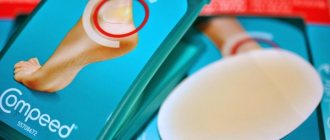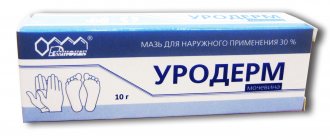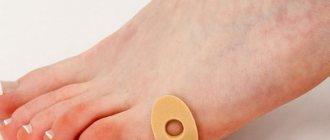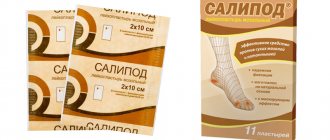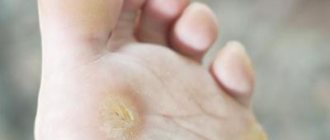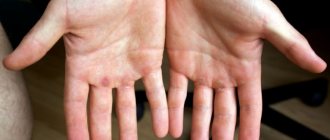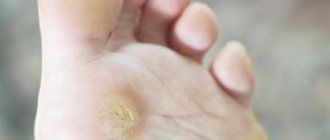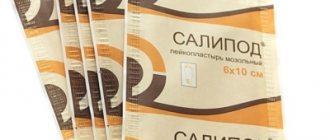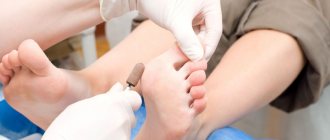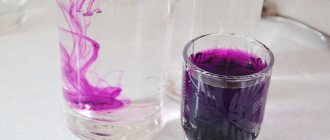Root or core callus is the most difficult type of callus to treat. A callus has a core (root) that is located deep in the skin and can even penetrate into soft tissue. This is a late stage of dry callus development.
Externally, such a callus looks like an area of keratinized skin, and inside it a funnel is visible. The formation is quite dense and causes pain when walking. In some cases, it is completely impossible to walk with such a callus - when the rod is already located deep enough and has penetrated into the soft tissue, squeezing the nerve endings.
Most often, calluses appear on the toes, under and between them, and on the heels. Interdigital calluses are the most painful.
Causes of such calluses
Root calluses are formed under the influence of internal and external factors. External - long-term and intense friction that occurs due to wearing too tight or uncomfortable shoes, as well as high-heeled shoes. Such a callus can also form as a result of a foreign body (for example, a splinter) getting into an untreated wound in a timely manner.
Callus can also appear due to internal reasons:
- the patient has dermatological diseases;
- increased sweating;
- lack of vitamins and microelements in the body;
- diabetes mellitus
Types of callus plasters
Calluses and corns vary in appearance and symptoms. Formations on the skin of the legs are:
- Wet, appearing as a small bubble filled with liquid. The cause is rubbing the skin with uncomfortable shoes.
- Dry, representing a localized, compacted area of the epidermis. They develop due to prolonged pressure on the same part of the foot.
- With a core, when a dry callus has a cone-shaped core that penetrates into the deep layers of the skin. Reaching the nerve endings, such a formation causes severe pain while walking.
Calluses in appearance are very similar to dry calluses without calluses, but have a much larger area. They represent an area of the epidermis of increased density with a yellowish tint. These tumors do not cause pain and are much easier to treat.
One of the easiest ways to eliminate a callus or corns is to use special patches. Moreover, it is necessary to choose the appropriate remedy based on the nature of the problem. Most often, calluses and corns are removed using the following types of patches:
| Type of patch | Description |
| Band-Aid | It is a piece of special adhesive tape, on which a pad with medicinal impregnation is applied. There may be a protective silicone or cellophane coating on top |
| Silicone | Made from silicone gel. It looks like a transparent strip with an adhesive surface. It is convenient because it is invisible when worn, as it is small in thickness. This patch can be glued to different parts of the body without fear of irritation. |
| Solipodous | The main active component of this patch is salicylic acid. After gluing the protective film, this substance penetrates into the deep layers of the epidermis and there has a softening effect on the coarsened layers. Has antibacterial and antiseptic properties |
| Liquid | When applied to a damaged area, it dries to form a protective film. The coating has an elastic structure and allows oxygen to pass through to the skin. Apply using a brush or spray. Protects against infection and promotes healing |
| Hydrocolloid | It is a sticky strip that provides a healing effect and prevents water from entering the damaged area of the skin. |
Diagnosis of calluses
For an experienced podologist, a visual examination of the patient is sufficient to identify the core callus. Correct diagnosis is essential to creating an effective treatment plan. That is why it is important to consult a specialist in a timely manner - a callus can easily be confused with a plantar wart, which forms on the same areas of the foot, but requires different therapy.
As additional studies, the patient may be prescribed blood tests for:
- sugar level;
- glycated hemoglobin;
- human papillomavirus (HPV);
- human immunodeficiency virus (HIV).
Contraindications and possible harm
Before applying the callus patch, be sure to study its composition and the attached instructions. The components of the impregnation can cause an allergic reaction, so not everyone can use them.
Contraindications for patches with keratolytic properties, in addition to individual intolerance, are:
- childhood;
- violation of skin integrity;
- dermatological diseases;
- damage to the skin of the foot as a result of diabetes.
The safest to use are silicone patches and pads. They can be used by everyone without restrictions, since they have no contraindications and do not have negative side effects.
Treatment of root callus
The treatment regimen is selected depending on the cause of callus formation and always involves the removal of the stratum corneum and the core of the formation. It is important to completely remove the root of the callus, otherwise the problem will recur again and again.
The easiest way to remove dead skin is with a hardware pedicure. The specialist selects the diameter of the machine's cutters, which are used to cut the skin, depending on the size of the callus and the depth of its core.
After removing the rod, its bed is treated with an antiseptic. Then an antibacterial ointment is placed in it.
What types of calluses can there be?
Calluses can be of the following types:
- Dry callus.
It is also called a hard callus. It can be shaped like a circle or an oval; the skin on it dies, so this callus is often yellow in color. If the callus is shallow, then it will not cause physical discomfort to the person. Such skin growths are purely a cosmetic defect. If the dry callus is large and deep, it can cause pain while walking.
- Wet callus.
In this case, the skin peels off with the formation of a bubble. It will be filled with lymph. It is a clear liquid that contains blood cells that perform a protective function. If the bubble bursts, the resulting gap can become an entry point for infection. You should not deliberately open wet calluses; you need to wait until they go away on their own.
- Dry callus.
Such a callus is a growth of keratinized skin cells, in the center of which there is a rod. It goes deep into the sole. If you do not get rid of the core, the callus will appear again and again. Therefore, treatment of such growths must be targeted. Often dry calluses are combined with various infectious processes, for example, a fungal infection.
Calluses most often form on the lower extremities. You can get rid of them with a patch. There are several types of patches. They all have different shapes and are also impregnated with different medicinal compounds.
Possible complications of core calluses
Lack of timely treatment of callus can lead to complications. The root of the callus is able to penetrate deep enough into the skin, squeezing the nerve endings. The patient's gait may change, even to the point of lameness, which even leads to disability - the pain caused by the callus can be so intense.
Calluses on the heels can bleed and fester. In this case, you need to contact a specialist immediately - such symptoms indicate the presence of an inflammatory process in the callus.
Podologist's advice
- Treat wet calluses in a timely manner, which over time can transform into dry calluses and then into core calluses.
- Wear shoes that fit comfortably. Avoid shoes with too thin soles. Don't wear stilettos all the time.
- Socks should be made from natural fabrics.
- Use antiperspirant for your feet if you suffer from excessive sweating.
- Maintain personal hygiene and do not wear other people's shoes.
- Watch your weight and use orthopedic insoles if necessary. It is not recommended to select them yourself; to do this, contact a specialist.
Callus patches: types and names
There are many patches for the treatment of calluses.
The best of them are considered to be such patches as:
- Salipod.
This patch allows you to get rid of old calluses that have a core. It is not used to treat wet calluses. Applying the patch to the skin allows you to have a pronounced bactericidal effect. Salipod contains not only salicylic acid, but also sulfur. These components soften even the roughest areas of the dermis well.
- Compid.
This is a practical and convenient patch that contains colloidal substances. They make the main active substance viscous, so it does not spread. Compide can be used not only to treat dry calluses, but also to heal wet calluses. For this purpose, a special form of patch is available for sale. They protect wet calluses from friction and pressure. Moreover, the manufacturer took care of producing patches that have a shape that is ideal for use in the spaces between the fingers.
- Urgo.
This patch can be used to treat calluses with and without a rod. The patch has a foam pad that prevents medicinal substances from coming into contact with healthy skin and damaging it.
- Leiko.
This patch is presented in the form of a thin ribbon. In its very center there is a plastic membrane. It contains the main active components of the patch. At the same time, it itself has excellent air permeability.
- Hartmann
cosmos.
This patch is suitable for the treatment of wet calluses. After applying it to the skin, the patch will absorb the secretion, creating a gel-like consistency. It promotes rapid tissue regeneration and pain reduction. Due to the presence of the patch on the callus, the pressure on it is reduced. Dirt, water and bacteria will not get into the wound. The patch contains hydrocolloid. - Salipod
patch.
This patch is suitable for the treatment of dry calluses, corns and skin tags. It is impregnated with sulfur and salicylic acid. In combination, these substances well soften the keratinized areas of the dermis, making it possible to reach the root of the callus and remove it. The main effects of using the salipod patch are: antibacterial, antiseptic, keratolytic and analgesic. Rubber and lanolin enhance the effect of sulfur and salicylic acid. Rosin, which is part of the patch, prevents the proliferation of bacterial flora.
Chinese patches are highly effective. They are limited by a special mesh that securely fixes the device on the skin, but at the same time allows it to breathe.
The best Chinese patches include:
- Dr. House.
This patch helps combat dry calluses. Its impregnation contains salicylic acid, which has a pronounced keratolytic effect. The patch is attached to the steamed callus and left on it for 2 days. During this time, the growth will soften and it will be easier to remove. It may take 3-4 treatments to completely get rid of the callus.
- Shuyangxuan
is a callus patch that is saturated with components actively used in Chinese medicine. It is represented by adhesive tape, which is equipped with a large membrane. It must be used within 6 days. During this time, the corn or dry callus will become softer and flake off. Using the patch may cause the skin to become red, but this reaction is normal.
-
Salicilic Acid and Phenol Plasters
for dry calluses and corns The impregnation composition of the patch includes salicylic acid, phenol, wax, petroleum jelly and lamb fat. Together, these components have a pronounced keratolytic, antibacterial and analgesic effect. Apply the patch to the callus steamed in a hot bath, and then leave it for a day. Then the patch must be replaced with a new one. The course of treatment is 3-4 procedures. This Chinese patch is not used to treat wet calluses.
Before using the callus removal patch, you should consult your doctor. Each such patch contains medicinal components, so they should be treated as a medication.
Video: getting rid of calluses with the COMPEED patch:

